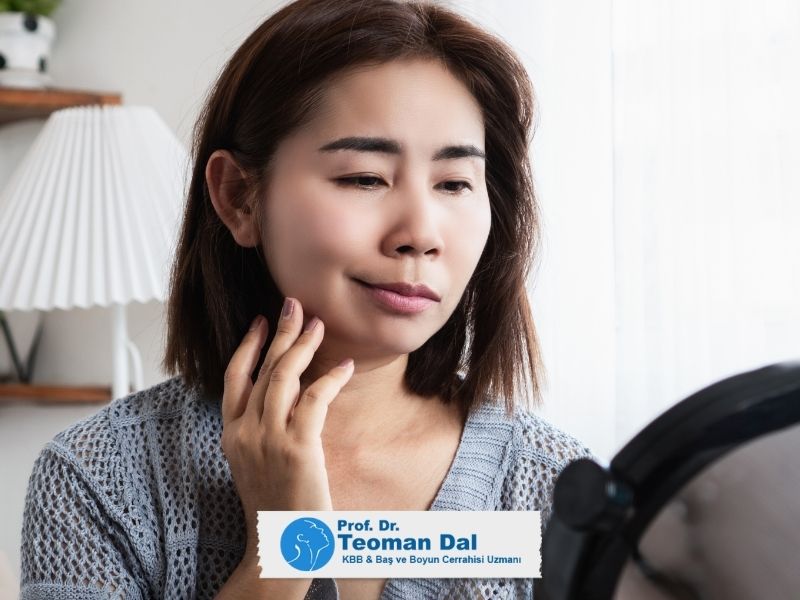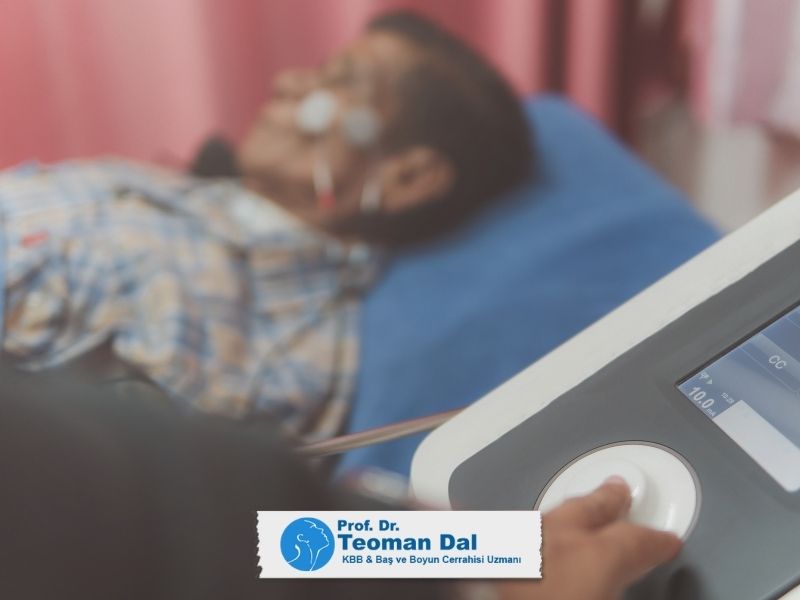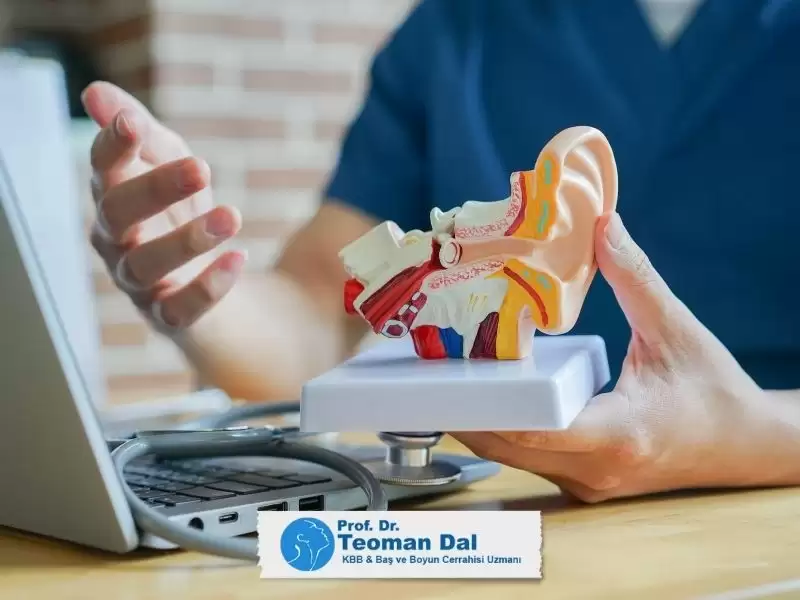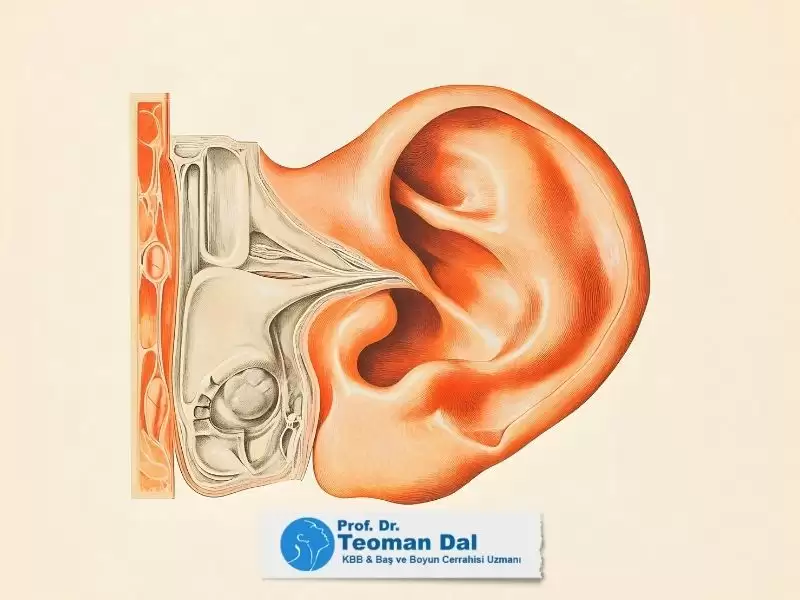Yüz felci; yüz kaslarını kontrol eden fasiyal sinirin (yüz siniri) çeşitli nedenlerle hasar görmesi sonucu mimik kaslarının görevini yerine getirememesi durumudur. En uzun kemik kanalına sahip sinir olan yüz siniri, kulak kemiği içerisinden geçtiği için felçlerin yaklaşık %90’ı bu bölgedeki hastalıklara bağlı olarak gelişmektedir.
Yüz Felcinin Nedenleri
Yüz felci sebepleri, akut (hızlı gelişen) ve kronik (yavaş ilerleyen) olmak üzere iki ana grupta incelenebilir:
Akut Gelişen Yüz Felci Nedenleri:
- Bell paralizisi (sebebi bilinmeyen ve en yaygın görülen yüz felci tipi)
- Herpes Zoster Virüsü (Ramsey Hunt Sendromu)
- Guillain-Barré sendromu
- Lyme hastalığı, AIDS, Kawasaki hastalığı
- Otoimmün hastalıklar
- Orta kulak enfeksiyonları (akut/kronik)
- Kulak kemiği kırıkları ve travmalar
- Doğum travması
- Kulak ameliyatları sırasında oluşan travma
- Basınç travması
Kronik Yavaş İlerleyen Yüz Felci Nedenleri:
- Sinirin içinden geçtiği, kulak önünde yer alan Parotis tükürük bezi tümörleri
- Orta kulakta ve iç kulakta yer alan glomus tümörü, schwannoma gibi iyi huylu tümörler
- Kolesteatom (kulak kemiği içinde kemik erimesine neden olan enfeksiyon)
- Yüz sinirinin kendisinden kaynaklanan iyi huylu tümörler (nörinom)
- Metastatik (başka bölgeden yayılmış) tümörler
Santral ve Periferik Tip Yüz Felci
- Santral yüz felci: Beyin kaynaklıdır; genellikle yüzün alt yarısını etkiler.
- Periferik yüz felci: Sinirin beyinden çıktıktan sonraki kısmı etkilenir ve hastalık olan tarafta yüzün tamamında felç oluşabilir.
Bu ayrım, tanı ve tedavi yaklaşımı açısından önemlidir.
Yüz Felci Belirtileri
- Yüz kaslarında hareket kaybı
- Göz kapama güçlüğü
- Ağız köşesinin sarkması
- Yüzün felç olmayan tarafa doğru kayması
- Tat alma bozukluğu
- Gözyaşı azalması veya artışı
- Kulakta ağrı veya dolgunluk hissi

Yüz Felci Tanısı
Yüz sinirinin kulak kemiği içinde hangi seviyede etkilendiği yine yüz sinirinden farklı seviyelerde çıkan dalların sağladığı gözyaşı salgısı, dilde tat alma ve orta kulaktaki üzengi kasının işlevi gibi fonksiyonların değerlendirilmesi ile anlaşılabilir. Yüz felcine işitme ve denge problemleri de eşlik ediyorsa, sinir etkilenmesi tüm sinirlerin bir arada bulunduğu iç kulak bölgesindedir.
Gereken durumlarda sinirdeki hasarın derecesini ve iyileşme sürecini takip amacı ile elektriksel sinir testi (ENG) ve kas testi (EMG) ayrıca manyetik rzonans görüntüleme (MRI) yapılır
Yüz Felci Tedavisi
Tedavi, felce neden olan duruma göre planlanır. Temel amaç, yüz kaslarının işlevlerini yeniden kazandırmak, yüz simetrisini sağlamak ve komplikasyonları önlemektir.
Bell Paralizisi (nedeni bilinmeyen yüz felci):
- İlk 72 saatte kortizon tedavisi (gerekirse damar yoluyla başlanır, ağız yoluyla devam edilir)
- Antiviral ilaçlar eklenebilir
- Yüz kasları için sıcak uygulama, masaj, egzersiz
- Göz kuruluğu için koruyucu damlalar ve pomadlar ve gereken durumlarda gözün bandajla kapatılması
Travma Kaynaklı Felç:
- Kemiği kıran travmalar sonrası oluşan felçlerde hızlı cerrahi müdahale gerekebilir
- Sinir üzerindeki bası kaldırılır, gerekirse onarım yapılır

Orta Kulak İltihaplarına Bağlı Felç:
- Damardan antibiyotik ve kortizon tedavisi
- Tedaviye hızlı cevap vermeyen hastalarda iltihabın cerrahi yolla temizlenmesi gerekebilir.
- Özellikle kolesteatoma saptanan hastalarda orta kulaktaki enfeksiyonu temizlemeye yönelik cerrahi müdahale vakit kaybetmeden yapılmalıdır
Herpes Zoster Otikus (Ramsey Hunt Sendromu):
- Bu hastalarda genellikle yüz felci ile beraber aynı tarafta kulak kepçesinde, saçlı deride, yüzde veya dudaklarda uçuk benzeri kabarcıklı lezyonlar bulunur.
- Virüse özel antiviral tedavi gerekir
- Kortizon desteği eklenir
- İyileşme oranı Bell’s hastalığına oranla oldukça düşüktür (%10–22)
Tümör Kaynaklı Felçler:
- Genellikle cerrahi müdahale gerekir
- Parotis bezi tümörlerinde farklı cerrahi teknikler uygulanır
Erken Tanı ve Tedavinin Önemi
Yüz felci durumlarında en önemli unsur erken tanı ve hızlı tedavi sürecidir. Özellikle sinir tahribatının şiddetli olduğu hastalarda, ilk günlerde yapılacak müdahaleler iyileşme kalitesini doğrudan etkiler.
İlaç tedavileri ile iyileşme sağlanamayan hastalarda felcin başlamasından itibaren üç haftalık süre sonunda EMG testi yapılmalıdır. Test sonucunda iyileşmenin başladığını gösteren bulgular izlenmeyen hastalarda MRI tetkiki ile sinirdeki hasarın bulunduğu bölge kontrol edilir. Bu tetkikte belirgin bir lezyon saptanırsa bu lezyonun bulunduğu bölgede, belirgin lezyon saptanmazsa yüz sinirinin kulak kemiği içinde yol aldığı tüm kemik kanalın üzeri cerrahi olarak açılarak sinirin baskıdan kurtarılması önerilir.
Fasial Reanimasyon
Yüz felçleri sonrasında fonksiyonların tam olarak geri gelmediği hastalarda izlenen fonksiyonel ve estetik problemlerin giderilmesine yönelik olarak yapılan müdahaleler fasial reanimasyon olarak adlandırılmaktadır.
Bu işlemler mevcut problemin derecesine, bölgesine ve felç oluştuktan sonra geçen süreye göre değişen göz kapaklarına ağırlık uygulanması, farklı sinirlerin yüz sinirine bağlanması, şakak adelesinin ağız köşesine getirilmesi ya da vücudun başka bölgelerinden kas dokusunun damarları ve siniri ile beraber yüz bölgesine transfer edilmesi gibi farklı cerrahi tedavi seçenekleri içermektedir.





